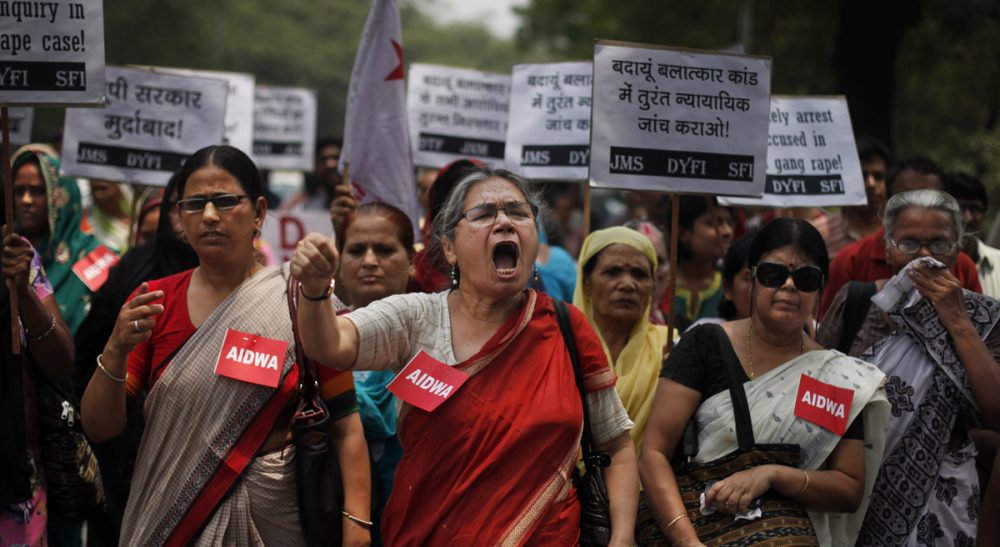Advertisement
In India, Dying To Go: Why Access To Toilets Is A Women’s Rights Issue

In May, two young women in rural India left their modest homes in the middle of the night to relieve themselves outside. Like millions in India, their homes had no bathrooms. The next morning, their bodies were found hanging from a mango tree. They had been attacked, gang-raped and strung up by their own scarves. Eighteen months after a gang-rape on a Delhi bus, this incident and others since have galvanized nationwide protests to end violence against women and highlighted caste-related discrimination. The tragic story also underscores the need to talk about another taboo topic: open defecation.
Access to clean, safe and private toilets is a women’s issue. An estimated 2.5 billion people globally lack access to proper sanitation, with the largest number living in India. Women are disproportionately affected by lack of adequate sanitation. Many poor women living in rural villages or urban slums wait until nightfall, reducing their food and drink intake so as to minimize the need for elimination. Girls often do not attend school if there are no private toilets, and this is especially true after the onset of menstruation. Approximately 2,200 children die every day as a result of diarrheal diseases linked to poor sanitation and hygiene, which impacts women as mothers and caregivers. Finally, waiting until nighttime to urinate or defecate is not only dehumanizing, it makes women vulnerable to sexual assault, as vividly illustrated by the appalling events in India.
…waiting until nighttime to urinate or defecate is not only dehumanizing, it makes women vulnerable to sexual assault, as vividly illustrated by the appalling events in India.
The world is slowly acknowledging the need to talk about toilets, but we need to do more. In 2010, the United Nations General Assembly and Human Rights Council recognized a human right to safe drinking water and sanitation. Through the Millennium Development Goals (MDG), the global community committed to a series of targets designed to address development challenges, including a 2015 goal of reducing by half the number of people without access to sanitation. However, the targets for sanitation are dismally behind. With the MDG targets set to expire soon, sanitation — and its role as a women’s issue — must be given high priority in forthcoming Sustainable Development Goals.
India has launched several large government programs to expand access to sanitation, but success has been elusive. India’s Total Sanitation Campaign, which has recently been re-branded as Nirmal Bharat Abhiyan, or Clean India Campaign, initially reported that close to 80 percent of India’s rural households had access to sanitation facilities. But the more reliable 2011 Census put the figure at only 31 percent.
Why is it that more people around the world have access to cellphones than to toilets? The evidence from India suggests that simply building toilets is not enough — there also needs to be demand. Open defecation is a traditional practice in rural India, and cultural biases can impede actual toilet usage. Even after a toilet is constructed, a family may use it for storing, bathing and washing purposes, but not for defecation.
People may stop using toilets once the waste chamber fills. Technical solutions are complicated by the legacy of India’s caste system. Historically, lower-caste individuals, usually women, manually removed human waste from dry latrines in a process known as "manual scavenging." While the practice is now outlawed, it still exists in various forms, and it remains, in the words of Mahatma Gandhi, a national shame.
Why is it that more people around the world have access to cellphones than to toilets?
Improving access to sanitation requires change across several scales of power. India needs to tap into its long-tradition of women’s self-help groups to promote critical peer-to-peer education, highlighting toilets as an issue not only of public health, but as one of safety and dignity. Because women are not necessarily household decision-makers, village-level approaches are needed. India has a complicated federal system, and the rural local bodies tasked with implementing central government projects require better skills and resources. Finally, technical solutions to the sanitation problem must never reinforce old caste-based and gender-based hierarchies.
The solution to this problem, while not easy, cannot wait, given the disproportionate impact that poor access to sanitation has on women around the world. If the promise of a human right to sanitation is to have any meaning, then the idea of human dignity that is at the core of human rights must apply to all people and transcend all aspects of daily life, even the parts that are taboo.
Advertisement
Related:
